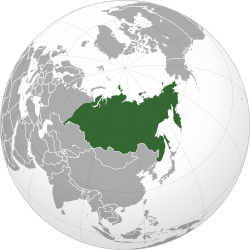Siberia
Сибирь | |
|---|---|
 | |
 | |
| Coordinates: 61°0′N 105°0′E / 61.000°N 105.000°E | |
| Continent | Asia |
| Country | Russia |
| Parts | |
| Area | |
• Total | 13,100,000 km2 (5,100,000 sq mi) |
| Population (2023) | |
• Total | 36.8 million[1] |
| • Density | 2.8/km2 (7/sq mi) |
| Demonym | Siberians |
| GDP (2022)[2] | |
| • Total | ₽ 41.783 trillion (USD 610 billion) |
| • Per capita | ₽ 1,120,921 (USD 16367) |
Siberia (/saɪˈbɪəriə/ sy-BEER-ee-ə; Russian: Сибирь, romanized: Sibir', IPA: [sʲɪˈbʲirʲ] ) is an extensive geographical region comprising all of North Asia, from the Ural Mountains in the west to the Pacific Ocean in the east.[3] It has formed a part of the sovereign territory of Russia and its predecessor states since the centuries-long conquest of Siberia, which began with the fall of the Khanate of Sibir in the late 16th century and concluded with the annexation of Chukotka in 1778. Siberia is vast and sparsely populated, covering an area of over 13.1 million square kilometres (5,100,000 sq mi), but home to roughly a quarter of Russia's population. Novosibirsk, Krasnoyarsk, and Omsk are the largest cities in the area.[4]
Because Siberia is a geographic and historic concept and not a political entity, there is no single precise definition of its territorial borders. Traditionally, Siberia spans the entire expanse of land from the Ural Mountains to the Pacific Ocean, with the Ural River usually forming the southernmost portion of its western boundary, and includes most of the drainage basin of the Arctic Ocean. It is further defined as stretching from the territories within the Arctic Circle in the north to the northern borders of Kazakhstan, Mongolia, and China in the south, although the hills of north-central Kazakhstan are also commonly included.[3][5] The Russian government divides the region into three federal districts (groupings of Russian federal subjects), of which only the central one is officially referred to as "Siberian"; the other two are the Ural and Far Eastern federal districts, named for the Ural and Russian Far East regions that correspond respectively to the western and eastern thirds of Siberia in the broader sense.
Siberia is known for its long, harsh winters, with a January average of −25 °C (−13 °F).[6] Although it is geographically in Asia, Russian sovereignty and colonization since the 16th century has led to perceptions of the region as culturally and ethnically European.[7] Over 85% of its population are of European descent,[8][9] chiefly Russian (comprising the Siberian sub-ethnic group), and Eastern Slavic cultural influences predominate throughout the region.[7] Nevertheless, there exist sizable ethnic minorities of Asian lineage, including various Turkic communities—many of which, such as the Yakuts, Tuvans, Altai, and Khakas, are Indigenous—along with the Mongolic Buryats, ethnic Koreans, and smaller groups of Samoyedic and Tungusic peoples (several of whom are classified as Indigenous small-numbered peoples by the Russian government), among many others.
- ^ "Предварительная оценка численности постоянного населения на 1 января 2023 г." Federal State Statistics Service. Archived from the original on 1 February 2023. Retrieved 21 February 2023.
- ^ Валовой региональный продукт по субъектам Российской Федерации в 2016–2022 гг., rosstat.gov.ru
- ^ a b "Siberia". Encyclopædia Britannica Online. Retrieved 22 September 2021.
- ^ "The Largest Cities in Siberia". August 2017.
- ^ Cite error: The named reference
bsewas invoked but never defined (see the help page). - ^ "Arctic Oscillation and Polar Vortex Analysis and Forecasts". Atmospheric and Environmental Research, Verisk Analytics. Retrieved 20 May 2018.
- ^ a b Haywood, A. J. (2010). Siberia: A Cultural History. Oxford University Press. ISBN 9780199754182.
- ^ "ВПН-2010". Perepis-2010.ru (in Russian). Archived from the original on 18 January 2012. Retrieved 3 April 2016.
- ^ "ВПН-2010". Gks.ru (in Russian). Archived from the original on 15 March 2013. Retrieved 3 April 2016.